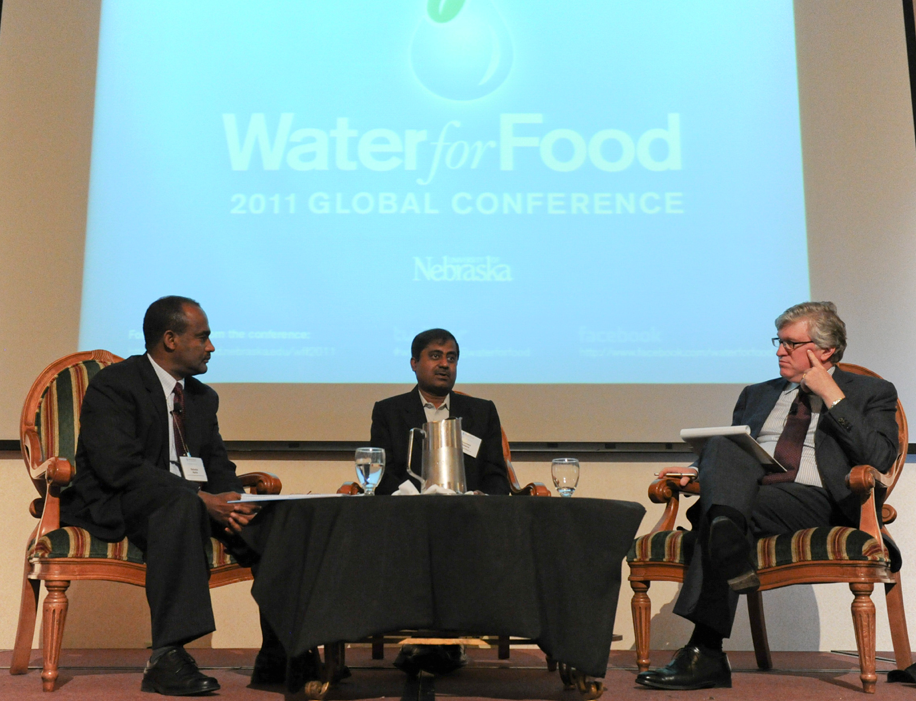
Feeding a growing world population with less water is “one of the greatest challenges of this century,” the CEO of the Bill & Melinda Gates Foundation said May 2 as the 2011 global Water for Food Conference opened.
Jeff Raikes said this year’s conference, the third, is critical in building an integrated, interdisciplinary approach to producing “more crop per drop” for a world whose food needs are projected to double over the next few decades. The conference is hosted by the Robert B. Daugherty Water for Food Institute of the University of Nebraska and the Gates Foundation.
Ultimately, Raikes said, these efforts aim to reduce poverty by helping farmers produce more efficiently and move beyond producing only enough food for their own families. He noted that of the 1.3 billion or so of the world’s population who live in extreme poverty - surviving on less than $1 per day - about 75 percent depend on subsistence agriculture.
The conference, at Lincoln’s Cornhusker Marriott Hotel through May 4, was expected to draw more than 400 producers, scientists, industry representatives and policymakers from more than 20 countries.
“The challenges are so numerous that we can’t expect to solve them all,” said James B. Milliken, NU President. But he noted that a “network of knowledge around the world,” as represented at the conference, is essential.
Representatives of two nations where subsistence farming is predominant - Ethiopia and India - underscored the challenges.
In India, for example, 80 percent of farmers produce only enough for their families, said Soumen Biswas, executive director of Professional Assistance for Development Action in that country.
“We do believe in technology. We do believe in markets,” Biswas said. But these farmers lack access to both, leading to a mindset that technology and markets are beyond them.
Social mobilization is one solution to getting producers to change their attitudes, Biswas said.
Kebede Ayele, country director of International Development Enterprises in Ethiopia, added that while better technology is important, it “has to be accompanied by education.
“We have to convince (farmers) and make them believe” they can be profitable in agriculture.
Historically, Raikes said, countries that moved beyond extreme poverty did so by improving agricultural productivity. “What ultimately happens is that improvement in agricultural productivity creates greater wealth in the economy” and opens up new opportunities.
Anil Jain, managing director of India-based Jain Irrigation System Ltd., said the change his company is effecting through introducing farmers to drip irrigation “is not incremental. We’re talking about transformational impact.”
Currently, about half his country’s farmland - the second-largest mass of arable land in the world - is rain-fed. Converting that land to irrigation-fed is essential, Jain said. Otherwise, “the scenario is quite scary.”
Jain said his company and others are promoting other efforts, including improved seeds and crop-management practices, capturing and storing rainwater, use of biotechnology and more.
He added that moving from rain-fed to irrigation-fed agriculture can increase income from up to $80 per hectare to as much as $1,520 per hectare.
“We have a long way to go,” Jain said.
A panel of industry representatives echoed the comments of the representatives from Ethiopia and India. Mogens Bay, chairman and CEO of Valmont Industries, said, “The efficient use of water is the biggest challenge agriculture has going forward.”
Agriculture currently uses about two-thirds of the world’s freshwater supply, and that is unsustainable in the future, he added. Bay said the technology that subsistence farmers need will be unaffordable initially, but those costs will drop over time.
“I’m convinced that we will meet this demand,” said Carl Hausmann, managing director of global government and corporate affairs for Bunge Ltd. “I think the question of how sensitively we meet this demand is something we all have to think about.”
Hausmann noted that the challenge is not just to produce the food but also to get it moved to the “consumption centers of the world” - largely urban areas.
Bay’s company, Valmont, a leading producer of center-pivot irrigation equipment, was founded by the late Robert B. Daugherty. The Robert B. Daugherty Charitable Foundation last year provided a $50 million founding gift to establish the Water for Food Institute at the university, which recently was named for him. Milliken said the Robert B. Daugherty Water for Food Institute is building international partnerships to address both educational and research needs. The pace of that work will quicken later this year when the institute hires its first director, he added.
- Dan Moser, IANR News Service
More details at: http://go.unl.edu/wff2011